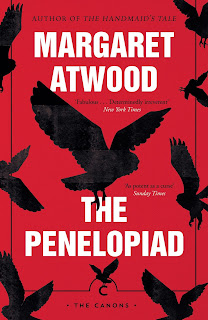See What I Have Done by Sarah Schmidt
 Little Miss Did-She-Didn't-She
Little Miss Did-She-Didn't-She
See What I Have Done by Sarah Schmidt is a fictional account of the Borden murders, told from the point of view of Lizzie, her sister Emma, the maid Bridget and a Mysterious Other. It covers the day before and day of the murder, plus some follow-up years later.
Content Warning: Domestic abuse and some self harm. Some grisly murder victim descriptions. Avoid if you're emetophobic.
Story ✩★★★★
Although the Borden murders are a famous case, I didn't actually know much about it and chose not to research before reading the book. Having read other reviews from people who, I suspect, know the case quite well, I think this was the right thing to do. This novel is certainly not a procedural and does not go to great lengths to forensically analyse the evidence moment by moment, or attempt to come to definite conclusions about the murderer.
Instead, like Margaret Atwood's Alias Grace, Schmidt is more focused on the lives and feelings and impressions, though completely fictionalised, of the characters whose view she takes. This is not so much a story of grisly murder, as it is of the claustrophobia of family forced together long after the chicks should have flown the nest.
Lizzie and Emma are caught in the love-hate relationship of sisterhood and, I think, sisterhood where there is a large age gap -- where one sister has taken responsibility for the other, remembers very distinctly a life before the other, and and the resentments that that breeds. Both sisters are caught in the paradox of desperately wanting attention and love from the other, while simultaneously recognising that this cloying kind of love is damaging and they need their freedom.
There is, of course, a murder at the heart of this story -- but this almost takes a back seat. The book is not about the murder, but about what caused the murder. Although there is a hinted hypothesis at the end of the novel, it is not overly concerned with solving the case, but demonstrating how a cloying, dysfunctional family atmosphere could lead anyone to snap.
The only thing that snagged the story was Benjamin's narratives. I can understand Schmidt's desire to include the mysterious stranger, the possible home-invading killer -- and also the need for an external point of view, seeing the details of the family with a stranger's eyes. The way he is written, though, is pure hate. His blunt need for violence is distracting and heavy-handed in a novel otherwise pleasantly subtle and building.
Style ✩★★★★
This is where some people might be put off. Schmidt's style isn't exactly stream of consciousness, but it is definitely slightly abstract. She also likes to repeat motifs in a way other reviewers have found very irritating. Personally I enjoy it, perhaps finding it grated slightly in the last fifty or so pages.
Schmidt is very focused on the sense of smell, and the ideas of shared air. For me, this added to the claustrophobic feel of the book, the sense of a general lack of personal space for everyone involved. People, in this novel, are sacks of gas seeping into other people's air. they are smells that are inescapable, and Mr Borden is very clear that the windows are not to be opened.
The voices for each of the four characters were very distinct: Lizzie's more abstract way of thinking, her mind wandering, catching on specifics that she repeats to herself; Emma's constant struggle between what is her duty and her internal screams for independence; Bridget's constant discomfort and desire for home and a family life that isn't constantly seething under the surface; and Benjamin's pure lust for violence infusing every page. The title is not referenced in the novel, but is undoubtedly spoken by Lizzie, who constantly directs and demands the attention of others.
This isn't something I would normally comment on, but I do also have to praise Tinder Press on the physical book. The British edition is very striking, with it's blue cover (pictured above) and bright orange tinted page edges. It was also very easy to read, falling open without being too stiff, and not forcing me to crack the spine.
Substance ✩✩★★★
Something I found while reading See What I Have Done was a desire to compare it to other books -- We Have always Lived in the Castle, Frog Music, The Thirteenth Tale (Review Here), as well as Alias Grace as already mentioned. The connectivity of a book is always something that makes me think a story has good substance, has something that makes the reader think a bit deeper, consciously compare it to what has been read before.
For me, there were also comparisons to be made with Victorian texts that focus on the dichotomy of desire and responsibility, such as Jane Eyre and Wuthering Heights. The joy of the neo-Victorian is that these subjects can be explored openly, and they form a massive part of the novel and Schmidt's assessment of the murder itself. The reader is constantly directed to wonder, if the family relationships had been healthier, if the sisters weren't so co-dependent, if women's independence had been encouraged, would there have been a murder at all?
The Verdict ✩★★★★
I can see how this book wouldn't be for everyone, how some readers would become bored or frustrated with the repeated motifs or find the internal monologue elements a little slow. Personally, I loved both of these things. I really enjoyed the build of this book, the feeling that it was working to a crescendo that, in fact, just sort of fizzled out. The exploration of family dynamics, however, are the main reason to read See What I Have Done. Come to this book not for a grisly tell all about a Victorian homicide, but to enjoy the delicious discomfort of growing tensions, resentments and love-hate relationships.


Comments
Post a Comment